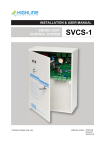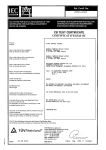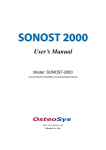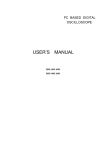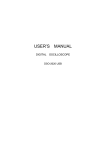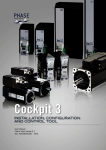Download User's Guide
Transcript
User’s Guide - SDS 200A - SoftScopePC Based Digital Oscilloscope www.softDSP.com Copyright softDSP CO., LTD.. All rights reserved. This document is being furnished by softDSP CO., LTD.. for information purposes only to licensed users of the SDS 200A and is furnished on as “AS IS” basis, that is, without any warranties, whatsoever, expressed or implied. SDS 200A and SoftScope are trademarks of softDSP CO., LTD.. Other brand and product names are trademarks or registered trademarks of the respective holders. Microsoft is a registered trademark and Windows, the Windows logo are registered trademarks of the Microsoft Corporation. Information in this document is subject to change without notice and does not represent a commitment on the part of softDSP CO., LTD.. 1 FCC NOTICE THIS DEVICE COMPLIES WITH PART 15 OF THE FCC RULES. OPERATION IS SUBJECT TO THE FOLLOWING TWO CONDITION: (1) THIS DEVICE MAY NOT CAUSE HARMFUL INTERFERENCE, AND (2) THIS DEVICE MUST ACCEPT ANY INTERFERENCE RECEIVED, INCLUDING INTERFERENCE THAT MAY CAUSE UNDESIRED OPERATION. This equipment has been tested and found to comply with the limits for a Class B digital device, pursuant to part 15 of the FCC Rules. These limits are designed to provide reasonable protection against harmful interference in a residential installation. This equipment generates, uses and can radiate radio frequency energy and, if not installed and used in accordance with the instructions, may cause harmful interference to radio communication. However, there is no guarantee that interference will not occur in a particular installation. If this equipment does cause harmful interference to radio or television reception, which can be determined by turning the equipment off and on, the user is encouraged to try to correct the interference by one or more of the following measures : - Reorient or relocate the receiving antenna. - Increase the separation between the equipment and receiver. - Connect the equipment into an outlet on a circuit difference from that to which the receiver is connected. - Consult the dealer of an experienced radio/TV technician for help. NOTE : The manufacturer is not responsible for any radio or TV interference caused by unauthorized modifications to this equipment. Such modifications could void the user’s authority to operate the equipment. 2 Declaration of Conformity Manufacturer softDSP Co., Ltd. Address Jungil Bldg 203, 552-1 Sungnae-dong, Kangdong-ku, Seoul, Korea Declares that the following product PC Based Digital Oscilloscope Model No. : SDS 200A Conforms to the technical regulations applicable to the product within the scope of the EMC Directive 89/336/EEC : EMCD EN 55022:1998+A1:2000 Class B EN 61326:1997+A1:1998+A2:2001 (Minimum immunity test requirements) (EN 61000-4-2:1995+A2:2001) (EN 61000-4-3:1996+A1:1998+A2:2001) (EN 61000-4-4:1995+A1:2001) (EN 61000-4-5:1995+A1:2001) (EN 61000-4-6:1996+A1:2001) (EN 61000-4-11:1994+A1:2001) The relevant technical file is available for inspection: Technical file SKTCEE-040713-114 SK TECH Co., Ltd. (DAR Registration No. DAT-P-076/97-01) 3 Certificate of Product Warranty This product’s warranty, provided by softDSP, Co., Ltd., covers a period of 1 year from the date of purchase. All faulty parts and/or functions, resulting despite user’s normal use, will be repaired and/or replaced at no charge during the warranty period. However, if any of the malfunctions are caused by user carelessness, inadequate maintenance, or natural disaster, softDSP will then provide repair and/or replacement services for a fee regardless of warranty period. In the event our product does not prove suitable for your application you can return the product for an exchange or refund. To claim, the product must be returned in good condition within 14 days. Before returning a product please contact and provide us a serial number. The customer is responsible for all shipping costs. Products covered by this warranty are limited to those that are registered at the softDSP headquarter or branch offices and repairs, replacements, or refunds will be issued according to manufacturer’s discretion. When in need of warranty services, the purchaser may visit our headquarter or one of our sales offices with the product or send the product with a detailed description of services required via postal service to any of our sales offices (the purchaser will be responsible for packaging, postage, and any postal insurance). Once repair services are completed, the supplier will return the product to the purchaser (return postage will be paid by the supplier). However, if we determined required services to be outside the boundaries of the warranty coverage, we will first contact the purchaser and provide an estimate of repair costs and obtain authorization to conduct services before any work is done. In such a case, return postage along with the repair costs will be billed to the purchaser when the repaired product is returned. softDSP do not warrant that the software and the product with which it was supplied are completely error free or that they will function correctly in all operating environments. It is essential that you, the user, should verify that the software and product are functioning to your requirements before relying on them or the data that they generate. softDSP does not accept responsibility for any loss or injury caused by the use of softDSP's product or software. It is the user's responsibility to ensure that the product is suitable for the user's application. softDSP Co., Ltd. will not be held legally liable for any malfunction resulting from user carelessness, abnormal use (e.g. ignorance of warning instructions, etc.), and/or natural disaster. Even if softDSP Co., Ltd. is in receipt of prior notification of such dangers, we will not be held legally liable. 4 Product Warranty Guide Please read through the “Precautions for Safety” carefully to obtain a long and safe use of this product. This product has been processed through careful quality control and testing procedures. Any malfunctions occurring during normal use are covered under the guidelines of the “Certificate of Product Warranty”, which is included in this Manual. If you experience product malfunction, please contact our headquarters or any of our sales offices. 5 Precautions for Safety The following instructions are provided for safe and correct use of the product and to prevent a potentially dangerous situation or damage in advance. Be sure to read through them before you use the product. Recommended Usage Environment The ambient temperature and relative humidity should be 0-40°C and 10-80% respectively for the normal operation of the product. Power Source The USB terminal and SDS 200A are connected via a USB cable for DC +5V power from the PC. The product does not require an outside power source. Warning: Be careful not to input excessive power voltage The product’s input power capacity is fixed as shown below to prevent electric shock and/or fire. Please DO NOT use voltage higher than that prescribed below. Probe Attenuation Maximum Input Voltage Input Impedance 1:1 42Vpk, AC 30Vrms, DC 60V 1MΩ 10:1 420Vpk, AC 300Vrms, DC 600V 10MΩ 100:1 4.2KVpk, AC 3KVrms, DC 6KV 100MΩ 1000:1 42KVpk, AC 30KVrms, DC 60KV 1GΩ (Warning) Be sure to check the probe attenuation before measuring the voltage. The voltage that is higher than the maximum input voltage can cause damage to the device and you. In particular, there is the risk of an electric shock when measuring high voltage. So you need to pay extra attention not to have your hand touch the terminal. 6 Please eliminate all unused probes or tester leads so that they do not come in contact with surrounding high voltage parts. Make sure that the PC’s power source is grounded. Handling Precautions The probe ground lead is at ground potential. Do not connect the ground lead to an elevated voltage. Connect the ground lead of the probe to earth ground only. If measuring the floating potential, we will recommend the measurement by the differential motion method using CH1 and CH2. CH1 CH2 Do not connect or disconnect the product with the probe or test lead which is connected to a voltage source. Do not attempt to operate the product at the situation that a risk of dysfunction or shock expected to happen. Stop using the product immediately when you notice something unusual about the smell, smoke or sound. And then remove the USB connection from your computer. Keep the product out of the reach of children or those who cannot be trusted with the use. Do not use the product with your hands wet. It can cause an electric shock. Do not try the product for the purposes other than those stated. 7 Usage Location If the products crevice is exposed to electric conductors (solids or liquids), the product will short circuit and possibly create dangers of electric shock or fire. Please keep this product away from humidity, water, or dust. DO NOT use this product near gas as well as other flammable and/or explosive materials. Store the product where direct sunlight can’t reach. Do not use the product where it’s dirty, other machines are operated, or there is a high level of electromagnetic waves. DO NOT place the product on an unstable cart, stand, or tripod. Such usage creates the dangers of accident and/or damage to product. Maintenance and Storage If not using it for a long term, remove the USB cable from the product. The recommended temperature and humidity for equipment storage is 25 °C at 50% humidity. After Service There are no parts that you can replace inside the product. Do not attempt replacing a part yourself. It can give you an electric shock. Do not attempt to open the case or repair yourself. It can cause an electric shock or other safety accidents. Once you open the case, you cannot have the privilege of an after-sales service. Call the After-service department at our headquarter through 82-2-470-0491 for repair. ([email protected]) 8 Minimum System Requirements To install and run SoftScope, you should have the following; Operating System Windows 98/ME/2000/XP CPU/Mainboard Pentium 200MHz , USB equipped mainboard Memory 32MByte HDD 20MByte Graphic Card Microsoft DirectX supported Screen resolution: 800x600 Color depth: 16bit 9 Table of Contents Ch 1. Introduction............................................................................................... 1 1. What is SDS 200A/SoftScope ? ................................................................ 1 2. Hardware Specification.............................................................................. 3 3. SoftScope Installation................................................................................ 5 4. SDS 200A Setup...................................................................................... 10 5. Setup SDS200A.inf under windows 2000 ............................................... 13 6. Probe Calibration..................................................................................... 15 Ch 2. How to use SDS 200A/SoftScope ......................................................... 16 1. Simple Measurement............................................................................... 16 2. Basic Operations ..................................................................................... 18 3. Print/Save Waveform............................................................................... 28 Ch 3. Advanced Technique.............................................................................. 32 1. Advanced Trigger..................................................................................... 32 2. FFT function............................................................................................. 34 3. Math......................................................................................................... 38 Ch 4. Toolbars, Menus, Dialog boxes & Screen Information....................... 39 1. Toolbar ..................................................................................................... 39 2. Screen Information .................................................................................. 41 3. Option Dialog Box.................................................................................... 43 4. Menu........................................................................................................ 44 Appendix ........................................................................................................... 48 Software Calibration .................................................................................... 48 ETS Calibration ........................................................................................... 49 10 Chapter 1. Introduction Ch 1. Introduction 1. What is SDS 200A/SoftScope ? 1. SDS 200A SDS 200A developed by softDSP CO., LTD. is a portable PC-based Digital Oscilloscope. High performance SDS 200A has the following features: 200MHz analog bandwidth, 5GS/s equivalent sampling, 100MHz real-time sampling. USB connected SDS 200A uses USB that supports plug’n play, with 12Mbps communication speed. Advanced trigger SDS 200A has advanced trigger circuitry so that it can detect many complex signals. Best performance for your dollar SDS 200A has many features that is comparable to the high speed stand-alone DSOs. But it costs a fraction of the price. No external power required SDS 200A does not need an external power source, because it is bus-powered from USB. 1 Chapter 1. Introduction 2. SoftScope SoftScope is a Windows software that controls SDS 200A. Easy to use SoftScope is easy to use. It is intuitive and easy to understand. Big screen SoftScope uses 500 x 400 screen size. Various data format processing SoftScope can save waveform in the following formats: text file, jpg/bmp graphic file, MS excel/word file. Fast screen update rate SoftScope uses Microsoft DirectX, so that it gives upto screens per second update rate. (under Windows98, Pentium II environment) Many kinds of measurements SoftScope has 23 measurement functions. The analog scope effect SoftScope uses digital persistence and histogram method so that the display resembles an analog oscilloscope screen. 2 Chapter 1. Introduction 2. Hardware Specification Input Max. sample rate Realtime sampling: 100MS/s using one channel, 50MS/s using two channels Equivalent sampling: 5GS/s Channels 2 Bandwidth 200 MHz (-3dB) Single shot bandwidth: 50MHz 20MHz bandwidth limiting function is available Vertical resolution 9 bits/channel Gain range 10mV ~ 10V/div @ x1 probe (10mV, 20mV, 50mV, 100mV, 200mV, 500mV, 1V, 2V, 5V, 10V/div 1,2,5 sequence) 100mV ~ 100V/div @ x10 probe 1V ~ 1000V/div @ x100 probe 10V ~ 10kV/div @x1000 probe Range 8 divisions Offset level +/-4 divisions Coupling AC, DC, GND Offset increments 0.02 div Impedance 1M ohm DC accuracy +/-3% Input protection 42Vpk (DC + peak AC < 10 kHz, without external attenuation) Display Mode Y-T, X-Y Timebase Timebase range 2ns/div ~ 10s/div ( 2ns, 4ns, 10ns, 20ns, 40ns, 100ns, 200ns, 400ns, 1us, 2us, 4us, 10us, 20us, 40us, 100us, 200us, 400us, 1ms, 2ms, 4ms, 10ms, 20ms, 40ms, 100ms, 200ms, 400ms, 1s, 2s, 4s, 10s /div 1-2-4 sequence) Acquisition mode Equivalent sampling: 2ns/div ~ 4us/div Realtime sampling: 10us/div ~ 400ms/div Roll mode: 1s/div ~ 10s/div Peak detection Range 10 divisions 3 Chapter 1. Introduction Pre/Post trigger 0% ~ 1000% Time resolution 200ps Buffer size 10K ~ 512K samples Trigger Type Edge trigger: Rising edge, falling edge Pulse trigger: Less than width, more than width (10ns ~ 167ms) Delay trigger: By event (1~16,777,215), by time (1us ~ 167ms) Mode Auto, Normal and Single HF Rejection Yes Autoset Yes Range 10 divisions Trigger level +/-4 divisions Settabillity 0.02 div increments Math Measurements Vp-p, Vmax, Vmin, Vmean, Vrms, Vamp, Vhigh, Vlow, positive overshoot, negative overshoot, cycle mean, cycle rms, period, frequency, positive pulse width, negative pulse width, rise time (10%~90%), fall time (10%~90%), positive duty cycle, negative duty cycle Cursor Time/frequency difference, voltage difference Frequency only in FFT mode Math Addition, Subtraction, Multiplication, Division FFT Rectangular, Hanning, Hamming, Blackman Window Physical Interface Universal Serial Bus (USB) Power No external power source required. Bus-powered from USB Dimensions 5.1" x 4.4" x 1.5" (130 × 112 × 38mm) 4 Chapter 1. Introduction 3. SoftScope Installation Caution!) You must install ‘SoftScope’ before using SDS 200A. 1. While in Windows, insert the installation CD into the CD-ROM drive. 2. The installation should start up automatically. Otherwise in Windows Explorer, switch to the CD-ROM drive and run Setup.exe. 3. The SoftScope Installation is started. Click ‘Next’ to continue. 4. If you accept the license agreement, click ‘Yes’ to continue. 5 Chapter 1. Introduction 5. Choose a destination directory. Click ‘Next’ to continue. 6. Select Language you use. Click ‘Next’ to continue. 7. Select Graph mode. Click ‘Next’ to continue. 6 Chapter 1. Introduction 8. Check the setup information. Click ‘Next’ to start copying of files. 9. This Status dialog is displayed during copying of files. 10. After Installing SoftScope, the installation program will check the DirectX version of your computer. If it is later than 6.0, the installation program will skip the DirectX Setup. 10.1 If it is earlier than 6.0 or no DirectX installed on your computer, you must reinstall DirectX. if you install from CD-ROM, DirectX Setup will start up. If you download SoftScope_with_DirectX.exe, DirectX will be installed automatically. If you download SoftScope.exe, you must download DirectX also. 7 Chapter 1. Introduction 10.2 Follow the directions of the DirectX Setup.( In case of installing the files downloaded from internet, you must download and install DirectX!) 11. Select if you reboot or not, you must reboot to use SDS 200A. 12. When computer restarts, new hardware is found. 13. New hardware search wizard starts. Select ‘Install the software automatically’ and then ‘Next’. 8 Chapter 1. Introduction 14. New hardware search wizard starts to search. 15. New hardware wizard installs software. 16. Finish new hardware search wizard. 9 Chapter 1. Introduction 4. SDS 200A Setup Caution!) SoftScope must be installed before using SDS 200A. This setup process is done once, at the first time of connection. 1. Connect the A-Type Plug of USB cable to your PC’s USB port. 2. Connect the B-Type Plug of USB cable to SDS 200A’s USB port. 10 Chapter 1. Introduction 3. When computer restarts, new hardware is found. 4. New hardware search wizard starts. Select ‘Install the software automatically’ and then ‘Next’. 5. Set the driver search location to CD-Rom and then ‘Next’. 11 Chapter 1. Introduction 6. New hardware search wizard starts to search. 7. New hardware wizard installs software. 8. Finish new hardware search wizard. 12 Chapter 1. Introduction 5. Setup SDS200A.inf under windows 2000 When SDS200A.inf file is not be detected automatically, you see the following dialog box. In this case you must install SDS200A.inf file manually. 1. Choose ‘Search for a suitable driver for my device’ button. Click ‘Next’ to continue. 13 Chapter 1. Introduction 2. Specify a location. Click ‘Next’ to continue. The SDS200A.inf file is located in SoftScope CD-ROM root directory. Specify the location by either entering or browsing. 3. SDS200A.inf file is detected automatically. Click ‘Next’ to continue. 4. Click ‘Next’ 14 Chapter 1. Introduction 6. Probe Calibration SDS 200A calibration 1. When manufactured, SDS 200A is calibrated manually to obtain maximum performance. 2. You may calibrate SDS 200A 5 or 6 months after purchase. Probe Compensation 1. You must use a probe with more than 200MHz bandwidth to get undistorted signal. 2. Probe should be compensated whenever it is connected for the first time. 3. Connect calibration signal to channel 1, then push AUTOSET. 4. Check the shape of the displayed waveform. 5. Adjust the probe until the displayed waveform is compensated. 15 Chapter 2. How to use SDS 200A/SoftScope Ch 2. How to use SDS 200A/SoftScope 1. Simple Measurement 1. Start SoftScope. 2. SoftScope checks the internal state of SDS 200A, USB communication status and then read initialization data. 3. Connect channel 1 probe to the calibration terminal. 4. Push the autoset button. 5. SoftScope sets vertical/horizontal scale automatically. 6. Join dots to a solid line. A. SoftScope displays the data from SDS 200A as a dotted line. B. To see the waveform more clearly, push the line-join icon. 16 Chapter 2. How to use SDS 200A/SoftScope 7. Add persistence effect. A. Persistence effect is analog-scope like effect that remembers the history of displayed waveforms. With persistence effect, you can see the more frequent line clearer. B. Change the persistence effect coefficient. 8. Change the intensity of the waveform. A. Just as in changing the persistence effect, you can change the intensity. B. By changing the scroll bar in the menu, you can see a more/less distinct line. 17 Chapter 2. How to use SDS 200A/SoftScope 2. Basic Operations Change Vertical Scale(Volt/Div) 1. Press the voltage change panel in the screen. (Same method to Channel 2, Math, Reference) - Select Volt/Div to change. - Voltage per scale is changed. 2. Press voltage change icon . - Shape of cursor is changed to , meaning Channel 1(When it is a channel 1). (The shape of cursor differs for each channel.) 3. Change vertical scale(volt/div) from menu and hot-key. A. Channel Ch1 Setting Volt Scale B. Press the appropriate hot-key. 4. Change AC/DC setting. A. Push the AC/DC icon to change. B. Push the same button once more to restore. Change Horizontal Scale(Time/Div) 1. Change horizontal scale(time/div) from panel. A. Push time scale change panel. B. Set the time/div scale with mouse or keyboard. C. Horizontal scale is changed. 18 Chapter 2. How to use SDS 200A/SoftScope 2. Change horizontal scale(time/div) with mouse button. A. Push time scale change icon. B. Cursor is changed to “T”. C. Push the left/right mouse button to change volt/div. D. With mouse that supports scroll button, change the trigger point. 3. Change horizontal scale(time/div) from menu and hot-key. A. Channel Time Scale. B. Press the appropriate hot-key. Measurement Using Cursor Measure voltage and time offset simply using mouse. A. : Can measure using horizontal and vertical axis at the same time. : Can measure using horizontal axis.(Measure Voltage) : Can measure using vertical axis.(Measure Period and Frequency) B. Push left mouse button, and the cross lines appear. 19 Chapter 2. How to use SDS 200A/SoftScope C. Drag the mouse button to the point you want to measure. D. Release the left mouse button, the voltage difference and time difference will be shown at the status bar. E. Push right mouse button, and the cross lines disappear. 20 Chapter 2. How to use SDS 200A/SoftScope Measurement by Icon SDS 200A has many measurement functions. -Peak-to-peak = Max – Min Pk-Pk -Measured over the entire waveform -Voltage of the absolute maximum level Max -Measured over the entire waveform -Voltage of the absolute minimum level Min -Measured over the entire waveform -Amp = Base – Top Amp -Measured over the entire waveform -Voltage of the statistical minimum level Base -Measured over the entire waveform -Voltage of the statistical maximum level Top -Measured over the entire waveform -Voltage of the 90% level from base to top Upper threshold -Voltage of the 50% level from base to top Middle threshold -Voltage of the 10% level from base to top Lower threshold -The arithmetic mean over the entire waveform Mean -The arithmetic mean over the first cycle in the waveform Cycle mean -The Root Mean Square voltage over the entire waveform RMS 21 Chapter 2. How to use SDS 200A/SoftScope - The Root Mean Square voltage over the first cycle in the waveform Cycle RMS - Positive Overshoot = (Max - Top)/Amp x 100 % Positive Overshoot - Measured over the entire waveform - Negative Overshoot = (Base - Min)/Amp x 100 % Negative Overshoot - Measured over the entire waveform - Time to take for the first signal cycle to complete in the waveform Period - Measured in seconds - Reciprocal of the period of the first cycle in the waveform Frequency - Measured in Hertz(Hz) - Time taken from lower threshold to upper threshold Rise time - Time taken from upper threshold to lower threshold Fall time - Positive Duty Cycle = (Positive Pulse Width)/Period x 100% Positive Duty Cycle - Measured of the first cycle in waveform - Negative Duty Cycle = (Negative Pulse Width)/Period x 100% Negative Duty Cycle - Measured of the first cycle in waveform - Measured of the first positive pulse in the waveform Positive Pulse Width - The time between the 50% amplitude points - Measured of the first Negative Pulse Width - View next icons Next 22 Chapter 2. How to use SDS 200A/SoftScope Upper/Lower Level Setting Set Upper/Lower Ratio Upper/Lower standard value should be given to obtain Rising Time and Falling Time. Upper/lower ratio for overall waveform(%) is set using this function and this value is used to calculate Rising/Falling Time Measurement. Change Trigger Level & Trigger Point 1.Set the trigger input source. A. With only one channel on, trigger input source is automatically set to the channel. With 2 channels on, you can choose trigger input source between the two. B. Change trigger source from the radio-button. C. Change trigger source from menu bar. EX) Trigger Trigger Source CH1 or CH2 D. Change trigger input source using hot key. 2. Change the trigger level. A. Move the trigger level icon, you can move the trigger level. 3. Change the trigger point. A. Move the trigger point icon, you can move the trigger point. 4. Change the trigger condition. A. Push the trigger up/down icon to change trigger condition. 23 Chapter 2. How to use SDS 200A/SoftScope B. Use menu or hot-key. ( Trigger Trigger Up/Down ) 5. Set delay on/off. A. Push the delay button to set delay on or off. B. When delay on, the trigger point separates from the horizontal expansion point. The horizontal expansion point stays at the center of the screen. Single Shot/Stop Mode 1. Change state to stop or single shot. , SDS 200A is in stop state. A. Push the stop button B. Every operation is the same as in the running state. 2. Single-shot action. A. Push the single-shot button to acquire only 1 waveform after the trigger condition you set. B. Single-shot is available only in Real Time mode. C. Push the single-shot button again to pause, SDS 200A waits for the trigger signal again. Put Label on The Screen 1. Add a label on the screen. A. Push the label icon. B. The mouse cursor is changed to 'I' shape. C. Push the left mouse button. D. Input string. 24 Chapter 2. How to use SDS 200A/SoftScope E. Change the text/back color. F. Push the confirm button to finish. G. Change the label by clicking the label again. XY Plot XY Plot acts to analyze correlation of data of two channels. Lissajous diagram is displayed in the screen when you use XY Plot, which enables to compare frequencies, amplitudes and phases of counterpart waveform against the reference waveform. This makes it possible to compare and analyze frequency, amplitude and phase between input and output. 25 Chapter 2. How to use SDS 200A/SoftScope Average Add acquired waveform as many as the number of average, calculate and display the average. Perform Moving Average for 2 waves to 256 waves and display it in the screen. Average function is applied to real time Mode and ETS Mode, and this function can not be used when role Mode and ETS Mode are turned off. Reference Reference waveform can be used after saving the waveforms in the channel 1 or channel 2. 26 Chapter 2. How to use SDS 200A/SoftScope Can work in ‘File’ of menu. Load Reference( ) : load Reference waveform saved in the form of file. Save Channel1 As Reference( ) : Save the current channel 1 as Reference waveform and load it as Reference waveform. Save Channel1 As Reference( ) : Save the current channel 2 as Reference waveform and load it as Reference waveform. Bandwidth Limit Eliminate high-frequency element of input signal. Signal over 20MHz is not accepted. Invert Invert the phase of input signal. Trigger High Frequency Reject Eliminate high-frequency element of trigger signal. Signal over 20KHz is not triggered. Peak Detect In peak detection mode, it accepts minimum and maximum amplitude from 2 continuous intervals and displays in the screen. Possibility of aliasing can be removed using peak detection function. 27 Chapter 2. How to use SDS 200A/SoftScope 3. Print/Save Waveform 1. Save acquired waveform in the following formats. A. Text File B. JPG/BMP File C. Excel File D. Word File 2. Save as text format. A. In Menu-> File-> ‘Save As DAT’ / Toolbar’, select ‘Save As DAT’ icon( B. Save after selecting the file name and location of saving. C. When reading the saved file, it appears as follows: 3. Save as JPG/BMP format. A. In ’Menu’ - ‘File’, select ‘Save As JPG’( ) or ‘Save As BMP’( B. Save after selecting the file name and location of saving. C. Option for saving of image can be selected in ‘File’ -> ‘Option’. 28 ). ). Chapter 2. How to use SDS 200A/SoftScope Example) Saved BMP File 4. Copy the image into clipboard. A. Select Copy from the File menu. B. Waveform is copied into clipboard. C. Paste the image into any program that supports clipboard paste. Following is the screen for copying the waveform to the image board using clip board. 29 Chapter 2. How to use SDS 200A/SoftScope 5. Transfer the data to MS Excel using ActiveX automation. A. Select Copy at the File menu. B. MS Excel is activated and then data is transferred by using ActiveX. 6. You can save the data to MS Word using ActiveX automation. A. In ‘Menu’ -> ‘File’, select ‘Save As Word’. B. MS Word is activated and then data is transferred by using ActiveX. 30 Chapter 2. How to use SDS 200A/SoftScope 7. Print the waveform. A. Display the waveform, by selecting ‘Print’ / Toolbar printer icon( ) in ‘Menu’-> ‘File’. B. Display the screen to print by selecting Preview’ / Toolbar preview icon ( Example) Preview screen 31 ) in ‘Menu’-> ‘File’->‘. Chapter 3. Advanced Technique Ch 3. Advanced Technique 1. Advanced Trigger You can return to normal trigger mode by uncheck Logic, Pulse, Delay check box in the advanced trigger dialog box. (Normal trigger mode) (Advanced trigger mode) Edge Trigger The Edge Trigger generates a trigger when the source signal passes through a specified level in either positive or negative direction, set by the user. This is the same trigger type found in a conventional analog oscilloscope. The source, the slope and the level must be set for Edge Trigger operation. Source: CH1/CH2 -Selects the trigger source. Slope: Up Edge/Down Edge -Selects the slope of the source. Level: +/- 4 vertical screen divisions (Full screen range) 32 Chapter 3. Advanced Technique -Selects the level of the input signal where the Edge Trigger is generated. The level is selected by trigger level pointer at the right-hand side of the display screen and the source is selected from the tool bar radio button. Pulse Trigger The Pulse Trigger generates a trigger if the pulse width of the input signal is either less or more than the preset time. Equation: Less than/More than - Selects whether the trigger is generated when the pulse is less than or more than the preset pulse time value. Time: 10ns ~ 167ms - Selects the pulse width time Delay Trigger The Delay Trigger generates a trigger by waiting for a preset time or number of events after a primary trigger from combination of edge, logic and pulse trigger is generated and when the first trigger from the secondary trigger source is detected. Equation: By time/By event - Selects the delay condition either by time or by event. Delay condition : By Time(1us~167ms), By Event(1~16,777,215 event) => When operating By event, two inputs of Delay trigger is called Primary trigger and Secondary trigger respectively. Due to features of hardware, delay time of 1us exists before first effective input of Secondary trigger comes after satisfying Delay conditions by input of Primary trigger. Secondary trigger source: CH1/CH2 - Selects the trigger source of the secondary trigger. Secondary trigger slope: Rising/Falling - Selects the slope of the secondary trigger. 33 Chapter 3. Advanced Technique 2. FFT function FFT(Fast Fourier Transform) This function analyze the frequency component of current waveform. 1. Pushing the FFT icon, the FFT dialog box appears. < The voltage component analyzed using FFT is displayed as Volt unit, and the value transformed as log scale or by other computation is displayed as rms(root mean square) value.> 2. The left setting menu of the FFT dialog box. Channel Sets input source for FFT analysis Window Type Sets digital filter type No. of Freq Bins Sets size of digital filter Scale Type Sets y scale type as Linear or Log scale Vertical Scale Sets vertical scale Frequency Scale Sets horizontal scale 34 Chapter 3. Advanced Technique If the information is more than the quantity displayed to the display window, more information is displayed by using scroll bar. 3. The above menu bar of the FFT dialog box :Save the FFT information as various data type Save As Text : This Button saves the FFT information as text formation. Save As Excel : This Button transfers the FFT information to MS Excel using ActiveX automation. Save As Bmp : This Button saves the FFT information as Bitmap Image. Save As Jpg : This Button saves the FFT information as Jpeg Image. : This shows the information of Cursor. Example) This means that frequency of cursor point is 3.6MHz and amplitude is 0.029Volts. :FFT Cursor On/Off 4. The below information window of the FFT dialog box : This shows the information of Harmonics. : This shows the information about measurement of FFT. : Amplitude of the fundamental frequency : Sum of Amplitude of Harmornic(excluding fundamental frequency) 35 Chapter 3. Advanced Technique : Sum of Noise (excluding fundamental frequency, Harmonics, DC and Nyquist bins) : Total Number of bins : Total Number of bins of Harmonic : Total Number of bins of Noise. SNR(Signal to Noise Ratio) : The ratio of the amplitude of the fundamental frequency to the Noise. ENOB(Effective Number of Bits) : The number of bits in an ideal converter that would be required to give the same SNR performance. SINAD(Signal to Noise and Distortion) : The ratio of the amplitude of fundamental frequency to the Noise, but Noise include Harmonics. THD(Total Harmonic Distortion) : The ratio of the rms sum of the harmonics to the rms value of the fundamental. SFDR(Spurious Free Dynamic Range) The ratio of the rms signal amplitude to the rms value of the peak spurious spectral component. The peak spurious component may or may not be a harmonic. : The rms value of the peak spurious spectral component. Total Power : The rms value of the sum of all spectral components. : Sum of Noise excluding DC and Nyquist. 36 Chapter 3. Advanced Technique 5. The FFT display window :Each green cross points to the Harmonics and red cross points to the cursor. A coordinate axis of X displays the frequency and a coordinate axis of Y displays the amplitude of the frequency. The scrollbar of horizontal and vertical move the base of coordinate axis of X and Y. 37 Chapter 3. Advanced Technique 3. Math Add/Subtract/Multiply/Divide the two waveforms. 1. Push the Math icon. Src1/Src2 Sets input source. Operator Sets operation method 2. Select source 1, source 2 and operator from the dialog box. Example) Input1 waveform + Input2 waveform 38 Ch 4. Toolbars, Menus, Dialog boxes & Screen Information Ch 4. Toolbars, Menus, Dialog boxes & Screen Information 1. Toolbar 1. Save As Dat -Save as “.dat” file 2. Preview -Previews current waveform 3. Print -Prints current waveform 4. Option -Shows option dialog box 5. Label -Shows label on the screen 6. Cross Cursor -On/Off function of Cross Cursor 7. Horizontal Cursor -On/Off function of Horizontal Cursor 8. Vertical Cursor -On/Off function of Vertical Cursor 9. Persistence -Sets persistence time 10. Intensity -Sets intensity of the waveform 11. Line Join -Joins the dots to lines 12. ETS ON/OFF -Sets ETS(Equivalent Time Sampling) On/Off 13. Run/Stop -Starts waveform acquisitions -Stops waveform acquisitions 14. Single Shot -Executes a single-shot acquisition 15. Auto Shot -Adjusts the vertical, horizontal, and trigger controls for a usable display automatically 16. FFT -Shows FFT dialog box 17. Channel 1 On/Off -Channel 1 On/Off 18. Channel 1 AC/DC/GND -Select Channel 1 AC/DC/GND 19. Channel 1 Voltage Scale -Adjust Channel 1 Volt/Div 20. Channel 2 On/Off -Channel 2 On/Off 21. Channel 2 AC/DC/GND -Select Channel 2 AC/DC/GND 22. Channel 2 Voltage Scale -Adjust Channel 2 Volt/Div 23. Math On/Off -Math On/Off 24. Math Voltage Scale -Adjust Math Volt/Div 25. Reference On/Off -Reference On/Off 39 Ch 4. Toolbars, Menus, Dialog boxes & Screen Information 26. Reference Voltage Scale -Adjust Reference Volt/Div 27. Time/Div -Adjust Time/Div 28.Delay On/Off -Sets trigger delay on -Sets trigger delay off 29. Trigger Source -Sets trigger source to a specific channel 30. Trigger Up/Down -Triggers on the rising edge of the signal -Triggers on the falling edge of the signal 31. Auto/Normal Trigger -Enables free running waveform acquisitions -Triggers only on valid trigger events 32. Advanced Trigger -Shows advanced trigger dialog box 40 Ch 4. Toolbars, Menus, Dialog boxes & Screen Information 2. Screen Information SoftScope has the following windows to show the internal states and settings. 1. : Channel 1 Window - Display current probe Attenuation (1:1, 1:10, 1:100, 1:1000). - Display current Volt/Div. - Click mouse to change set up value. 2. Configuration of Channel 2 Window( Reference Window( 3. ) , Math Window( ), ) is same as the Channel 1 window. : Time Window - Display current Time/Div. - Click mouse and change set up value. 4. : Trigger status display window A. When SDS 200A is in a delay-on state it shows the current trigger point using time dimension. B. When SDS 200A is in a delay-off state it shows the current trigger point using % scale. : Trigger point display window 5. A. B. C. D. 6. The trigger point shows the trigger position in the acquired waveform. This line shows the whole acquired waveform. You can see the data currently showing using [ ] mark. This mark shows the reference point when horizontal scale(time/div) is changed. : Trigger state selection tool bar A. Trigger source selection radio button 41 Ch 4. Toolbars, Menus, Dialog boxes & Screen Information B. Trigger mode (Auto/Normal) C. Trigger condition (Up edge/Down edge) D. Trigger state display window. Display trigger source, trigger mode, trigger type, trigger slop and trigger level. 7. : Trigger state of current acquired waveform A. Auto - Trigger signal is automatically generated because of no valid triggered signal. B. Trig? – SDS 200A is waiting for the incoming trigger. C. Trig'd – Acquired waveform is triggered. 42 Ch 4. Toolbars, Menus, Dialog boxes & Screen Information 3. Option Dialog Box Title Check to include title on file/print output, use to set the title on file/print output Format Sets color or Black/white type Include : Check to include information on file/print output Include Date Include Date on file/print output Include Setup Information Include Setup Information on file/print output Invert Background Sets the Invert Background Grid View : Sets the grid type Boundary On Sets the Boundary On/Off Cross On Sets the center cross line On/Off Grid On Sets the grid On/Off Grid Color Sets the color of grid Channel Color Level Sets color level of waveform, check to display waveform in color 43 Ch 4. Toolbars, Menus, Dialog boxes & Screen Information 4. Menu File Name Sub Menu Operation Hot-key Load State Load saved state of SoftScope F2 Save State Save state of SoftScope F3 Save As DAT Save as DAT File format Ctrl +S Save As JPG Save as JPG File format Save As BMP Save as BMP File format Save As Word Saves waveform as word file F4 Save As Excel Saves waveform as excel file F5 Option Selects the waveform or screen F6 option Copy Saves waveform to clipboard Load Reference Load Reference file. Save Channel1 As Save and load channel 1 waveform as Reference Save Channel2 Ctrl + C Reference waveform As Save and load channel 2 waveform as Reference Reference waveform Preview Previews the waveform F7 Print Prints the waveform Ctrl + P Exit Stops the SoftScope and return Ctrl + X View Operation Hot-key File Toolbar Shows/Hides File Toolbar Ctrl + F1 Display Toolbar Shows/Hides Display Toolbar Ctrl + F2 Channel Toolbar Shows/Hides Channel Toolbar Ctrl + F3 Run/Stop Toolbar Shows/Hides Run/Stop Toolbar Ctrl + F4 Trigger Toolbar Shows/Hides Trigger Toolbar Ctrl + F5 Util Toolbar Shows/Hides Util Toolbar Ctrl + F6 Full Screen Display Full Screen Alt + Enter Name Sub Menu 44 Ch 4. Toolbars, Menus, Dialog boxes & Screen Information Display Operation Hot-key Line Join On/Off Joins the waveform with line Ctrl + J Persistence Changes the persistence effect Ctrl + E + Increases intensity of waveform Ctrl + Inc _ Decreases intensity of waveform Ctrl + Del Label Edit On/Off Inserts text to waveform Ctrl + L Cross Cursor On/Off On/Off Cross Cursor Ctrl + U Horizontal Cursor On/Off On/Off Horizontal Cursor Vertical Cursor On/Off On/Off Vertical Cursor Name Sub Menu Intensity Channel Name Sub Menu Operation Hot-key Channel1 On/Off On/Off Shift + F1 Voltage Change Volt/Div setting Shift + F5 Probe Attenuation Change Probe Attenuation AC/DC/GND Coupling Change AC/DC/GND Invert On/Off Change phase of waveform Bandwidth Limit Bandwidth limit On/Off On/Off Shift + F7 Voltage Change Volt/Div setting Shift + F11 Probe Attenuation Change Probe Attenuation AC/DC/GND Coupling Change AC/DC/GND Invert On/Off Change phase of waveform Bandwidth Limit Bandwidth limit On/Off On/Off Voltage Change Volt/Div setting Probe Attenuation Change Probe Attenuation Math Option Set Option of Math On/Off On/Off Voltage Change Volt/Div setting Probe Attenuation Change Probe Attenuation Channel2 Math Reference 45 Shift + F2 Shift + F8 Ctrl + M Ch 4. Toolbars, Menus, Dialog boxes & Screen Information Horizontal Name Sub Menu Operation Hot-key Time/Div Change Time/Div setting Ctrl + T Delay On/Off On/Off Delay Ctrl + D Trigger Sub Menu Name Operation Hot-key Trigger Source CH1 Selects CH1 from trigger source Shift+Ctrl+F1 Trigger Source CH2 Selects CH2 from trigger source Shift+Ctrl+F2 Slope Selects Up/Down from Trigger Up/Down Shift+Ctrl+F3 Auto/Normal Selects Normal/Auto from Trigger Normal/Auto Shift+Ctrl+F4 Advanced Trigger Selects Advanced trigger Shift+Ctrl+F5 Trigger High Frequency Eliminate trigger high-frequency Reject On/Off Acquire Name Sub Menu Operation Hot-key Run/Stop Starts/Stops acquiring waveform Ctrl + R Single Shot Begins Single Shot operation Ctrl + H Auto Set Changes horizontal/vertical scale for waveform Ctrl + A ETS On/Off On/Off ETS Average Changes average count number Peak Detection Peak Detection On/Off Util Name Sub Name FFT Measurement Operation Hot-key Shows FFT form Ctrl + F Time - Voltage - Upper/Lower Level Upper/Lower XY plot On/Off On/Off XY plot Ctrl + Y Calibration Processes Offset calibration Shift+Ctrl+F6 46 Ch 4. Toolbars, Menus, Dialog boxes & Screen Information ETS Calibration Processes ETS calibration Measure Name Sub Menu Operation Hot-key Voltage Peak to Peak Measurement of Peak to Peak Voltage Ctrl+Alt + P Maximum Measurement of Maximum Voltage Ctrl+Alt + X Minimum Measurement of Minimum Voltage Ctrl+Alt + N Amplitude Measurement of Amplitude Voltage Ctrl+Alt + A Top Measurement of Top Voltage Ctrl+Alt + T Base Measurement of Base Voltage Ctrl+Alt + B Upper Measurement of Upper Voltage Ctrl+Alt + U Middle Measurement of Middle Voltage Ctrl+Alt + M Lower Measurement of Lower Voltage Ctrl+Alt + L Mean Measurement of Mean Voltage Ctrl+Alt + E Cycle Mean Measurement of Cycle Mean Voltage Ctrl+Alt + C RMS Measurement of RMS Voltage Ctrl+Alt + R Cycle RMS Measurement of Cycle RMS Voltage Ctrl+Alt + Y Positive Overshoot Measurement of Positive Overshoot Voltage Ctrl+Alt + S Negative Overshoot Measurement of Negative Overshoot Voltage Ctrl+Alt + G Period Measurement of Period Ctrl+Alt + I Frequency Measurement of Frequency Ctrl+Alt + F Rise Time Measurement of Rise Time Ctrl+Alt + V Fall Time Measurement of Fall Time Ctrl+Alt + Z Positive Duty Cycle Measurement of Positive Duty Cycle Ctrl+Alt + J Negative Duty Cycle Measurement of Negative Duty Cycle Ctrl+Alt + D Positive Pulse Width Measurement of Positive Pulse Width Ctrl+Alt + W Negative Pulse Width Measurement of Negative Pulse Width Ctrl+Alt + H Time Upper/Lower Set Upper/Lower ratio Level Help Name Sub Name Operation Hot-key Help Shows help file F1 About Displays about Dialog Box F9 47 Appendix Appendix Software Calibration It is necessary for you to calibrate regularly to make the measurements as accurate as possible 1. Short input signal as shown below. 2. Zero calibration dialog box appears. 48 Appendix ETS Calibration In ETS mode, waveform distortion may arise from the environmental changes. In this case, you can use ‘ETS calibration function’. 1. Connect channel 1 probe to the calibration terminal. 2. Set probe attenuation factor to 1:1. 3 . In ‘Util’ menu, select ‘ETS Calibration’. 4. Push the ‘start’ button and ETS calibration begins. 5. It takes about a minute for ETS calibration. 49





























































